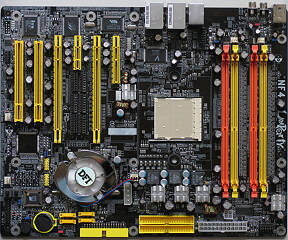 2
2
DFI LanParty UT NF4 Ultra-D Review
Layout continued »Board Layout
Click here for a 3000x2500 high-res shot of the board (3 MB download), the backside is here.
There is plenty of space around the CPU area. All MOSFETs have heatsinks on them to reduce thermal stress.
PS/2 Keyboard, PS/2 Mouse, SPDIF, Audio, Dual Gigabit Ethernet, six USB Ports. On the backside panel the most important connectors are included. The layout does not really follow the ATX specification, except for the PS/2 ports and the networking. But since an IO shield is included this is no big issue.
The motherboard's memory slots have been color coded for easy dual-channel configuration. To run your memory in dual-channel mode you have to put the modules into slots of the same color.
Connectors
Both the 24-pin ATX power connector and the ATX12V connector are placed in the best possible location I could imagine. Great work on this, DFI.
If you think your board needs more juice, DFI has added a 3.5" Floppy and a 5.25" Power connector the board. These supply additional power to the motherboard and help reduce the stress on the regular ATX power cables. Electrically, the 12V of ATX Power, ATX12V, 5.25" and 3.5" are connected together, same for the 5V line.
You will find two parallel ATA ports on this motherboard, for a total of four IDE devices. Both ports are provided by the nForce4 chipset and are spec'd to run at up to 133 MB/s.
While SATA-II is not much of a performance improvement, having four 300 MB/s capable ports is definitely a nice thing. The 90° angled connector is for the floppy, if you are one of the last people on this planet to use them. The HDDs can also be run in RAID 0, RAID 1 or RAID 0+1.
Some manufacturers color-code the Reset/Power/LED connectors, so it is easier to spot which pins belong together. DFI does not do this, but the pins are clearly labelled.
DFI has added a load of jumpers all over the board. While the other ones deal with SPDIF and USB power, these three are certainly more interesting.
From left to right:
Safe Boot: In case you are unable to start your system during your overclocking adventures, you switch this jumper to the 2-3 position when the system is powered down, wait a few seconds then switch it back to 1-2. Now all overclocking settings are reset, while the other CMOS settings are saved.
Speaker On/Off: Having a PC speaker onboard is crucial when it comes to detecting bootup problems. For day to day usage it might be annoying. switching this jumper into position 1-2 disables the onboard speaker. This is the default position. In my opinion it would have made more sense to enable it by default, since during the first install, there could be some problems.
Clear CMOS: When this jumper is set to 2-3 it will clear all contents of the CMOS. This is useful when the system does not boot or after upgrading your BIOS.
Another useful jumper is this block. In the default position, the memory voltage is generated from the 3.3V supply. In case you want to run your memory at a higher voltage you switch this jumper to position 2-3 and the range of possible DDR voltages is increased up to 4.0V. The heatsink you see on the picture, is cooling the DDR Voltage MOSFET, on the 4V setting it tends to get very hot. If you don't need more than 3.3V on your memory, better go with the 3.3V setting where you won't have to worry about MOSFET heat.
One of the most wanted features by overclockers are those little push buttons. One button is for power, the other one for reset. For quick builds this saves you from connecting switches to the headers, or using screwdriver to turn on the system. I like the buttons DFI used a lot, they are big and have a clearly defined switch-point.
Apr 25th, 2024 17:45 EDT
change timezone
Latest GPU Drivers
New Forum Posts
- Best SSD for system drive (77)
- Ubuntu 24.04 LTS released (2)
- Dell Workstation Owners Club (3054)
- Which new games will you be buying? (313)
- TPU's Nostalgic Hardware Club (18463)
- im new to throttelstop and i think i messed it up by copying others any hints would be very much aprreciated (2)
- Ryzen Owners Zen Garden (7243)
- What software are you using to monitor CPU temps during gaming session? (15)
- ROG Strix LC III 360 ARG AIO What should the pump speed be? (4)
- Ghetto Mods (4322)
Popular Reviews
- Fractal Design Terra Review
- Thermalright Phantom Spirit 120 EVO Review
- Corsair 2000D Airflow Review
- Minisforum EliteMini UM780 XTX (AMD Ryzen 7 7840HS) Review
- ASUS GeForce RTX 4090 STRIX OC Review
- NVIDIA GeForce RTX 4090 Founders Edition Review - Impressive Performance
- ASUS GeForce RTX 4090 Matrix Platinum Review - The RTX 4090 Ti
- MSI GeForce RTX 4090 Suprim X Review
- MSI GeForce RTX 4090 Gaming X Trio Review
- Gigabyte GeForce RTX 4090 Gaming OC Review
Controversial News Posts
- Sony PlayStation 5 Pro Specifications Confirmed, Console Arrives Before Holidays (116)
- Windows 11 Now Officially Adware as Microsoft Embeds Ads in the Start Menu (106)
- NVIDIA Points Intel Raptor Lake CPU Users to Get Help from Intel Amid System Instability Issues (106)
- AMD "Strix Halo" Zen 5 Mobile Processor Pictured: Chiplet-based, Uses 256-bit LPDDR5X (101)
- US Government Wants Nuclear Plants to Offload AI Data Center Expansion (98)
- AMD's RDNA 4 GPUs Could Stick with 18 Gbps GDDR6 Memory (87)
- Developers of Outpost Infinity Siege Recommend Underclocking i9-13900K and i9-14900K for Stability on Machines with RTX 4090 (85)
- Windows 10 Security Updates to Cost $61 After 2025, $427 by 2028 (84)












